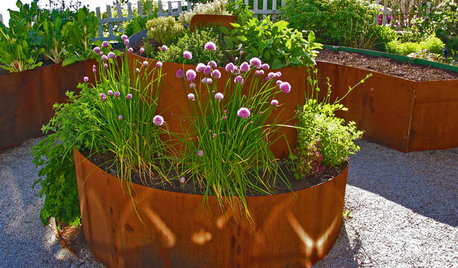Advice for first time growing tomatoes in container
mihaip123
9 years ago
Related Stories

EDIBLE GARDENSSummer Crops: How to Grow Tomatoes
Plant tomato seedlings in spring for one of the best tastes of summer, fresh from your backyard
Full Story
FARM YOUR YARDHow to Grow Vegetables in Containers
Get glorious vegetables and fruits on your patio with a pro’s guidance — including his personal recipe for potting mix
Full Story
FARM YOUR YARD10 Easy Edibles to Grow in Containers
These herbs, vegetables and fruits are just as happy in a pot as they are in the ground
Full Story
BATHROOM DESIGNDreaming of a Spa Tub at Home? Read This Pro Advice First
Before you float away on visions of jets and bubbles and the steamiest water around, consider these very real spa tub issues
Full Story
GARDENING GUIDES10 Easy Edibles for First-Time Gardeners
Focus on these beginner-friendly vegetables, herbs, beans and salad greens to start a home farm with little fuss
Full Story
FALL GARDENING5 Fall Fruits You Can Grow in Containers
Brighten your porch or patio with a potted pomegranate, kumquat, blueberry bush or another great fall fruit
Full Story
URBAN GARDENSContainers Make Growing Edibles a Cinch
If life hands you a lack of land, grow lemons — with a few basics, you can proudly reap the fruits, veggies and herbs of your labor
Full Story
FARM YOUR YARD6 Things to Know Before You Start Growing Your Own Food
It takes time and practice, but growing edibles in the suburbs or city is possible with smart prep and patience
Full Story
FARM YOUR YARDAdvice on Canyon Farming From L.A.'s Vegetable Whisperer
See how a screened garden house and raised beds help an edible garden in a Los Angeles canyon thrive
Full Story
EDIBLE GARDENSWhy Grow Quince? For Beauty, Fragrance and Old-Time Flavor
Delightfully perfumed fruit and lovely spring blossoms make this apple and pear cousin worth a spot in the garden
Full StoryMore Discussions






mihaip123Original Author
mihaip123Original Author
Related Professionals
Clemson Landscape Architects & Landscape Designers · Ilchester Landscape Architects & Landscape Designers · Cudahy Landscape Contractors · Nutley Landscape Contractors · Palatine Landscape Contractors · Wanaque Landscape Contractors · Longview General Contractors · Mobile General Contractors · Roseburg General Contractors · Wheeling General Contractors · Chesapeake Ranch Estates Stone, Pavers & Concrete · Winchester Center Stone, Pavers & Concrete · Issaquah Decks, Patios & Outdoor Enclosures · Littleton Decks, Patios & Outdoor Enclosures · Richmond Decks, Patios & Outdoor Enclosuresmihaip123Original Author
mihaip123Original Author
mihaip123Original Author
seysonn
scottsmith
PupillaCharites
seysonn
PupillaCharites
mihaip123Original Author
mihaip123Original Author
suncitylinda
mihaip123Original Author
PupillaCharites
suncitylinda
suncitylinda
PupillaCharites
mihaip123Original Author
PupillaCharites